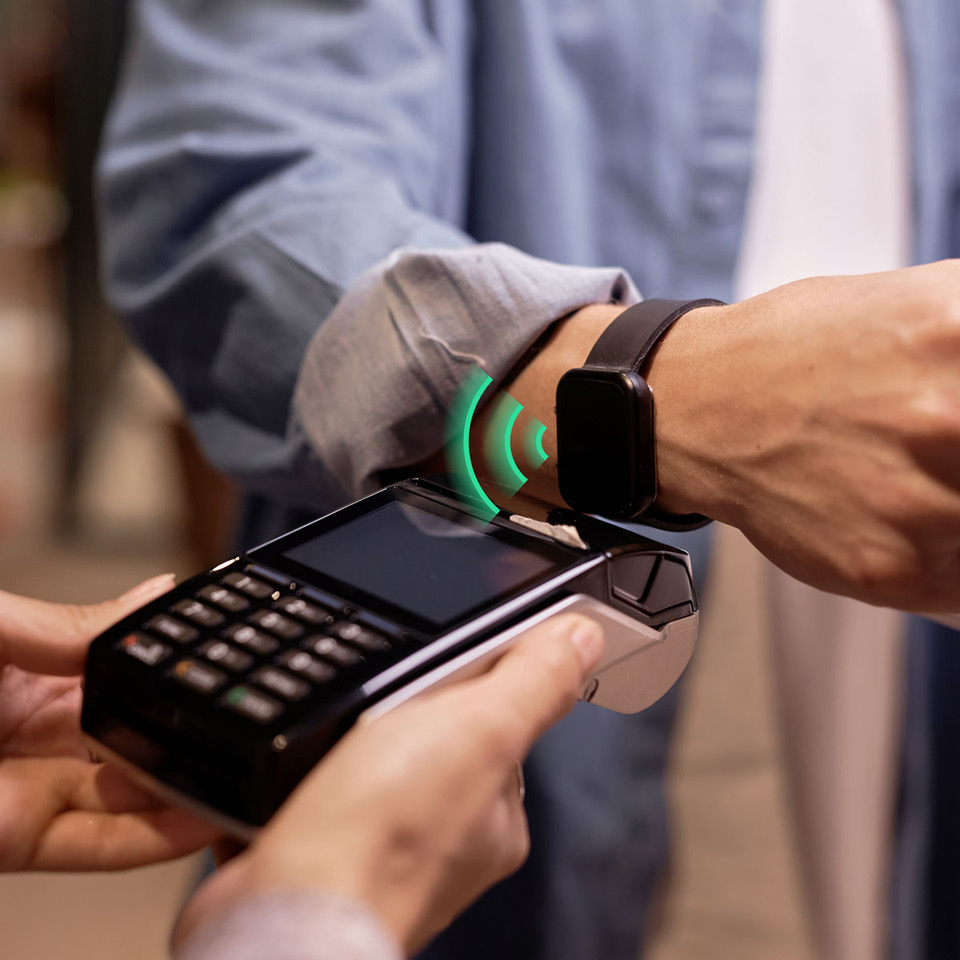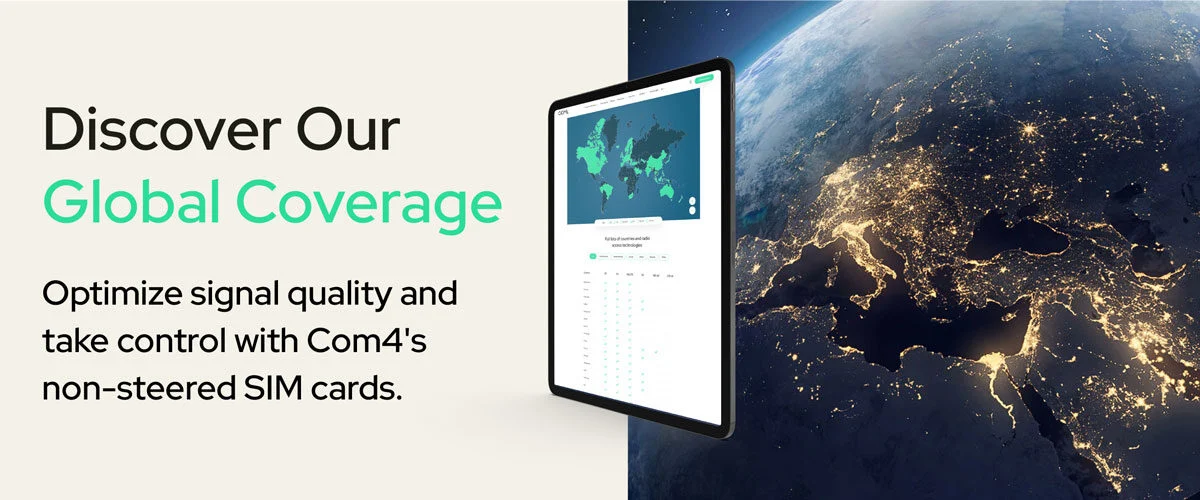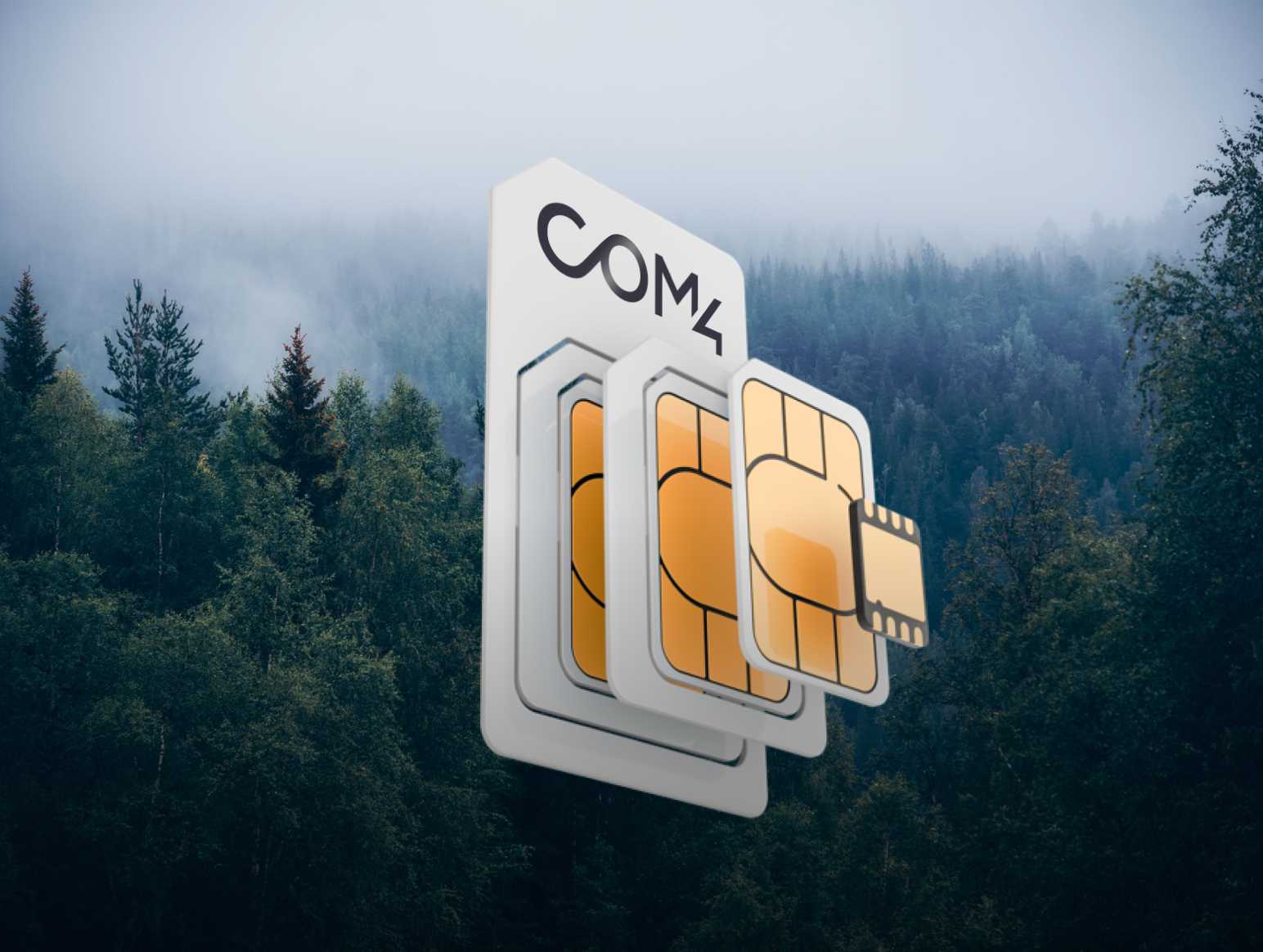Table of Contents
Introduction: why connectivity is the lifeline of modern payment terminals
The evolution of POS systems
Why cellular outperforms Wifi and Bluetooth for POS
Com4 in action: vending machines in Finland
The power of multi-network IoT SIMs
Future-proofing with eSIM and the SGP.32 standard
Typical data usage for payment terminals
Security best practices for POS connectivity
Top IoT use cases in retail: how connected technology is reshaping the shopping experience
Essential components of an IoT retail system
Why payment providers choose Com4
Introduction: why connectivity is the lifeline of modern payment terminals
Payment terminals—also known as point-of-sale (POS) systems—have undergone a dramatic transformation in recent years. Once limited to stationary cash registers, they are now sophisticated, cloud-connected hubs for transactions, inventory management, analytics, and even customer engagement.
From retail and hospitality to public transport, vending machines, and EV charging stations, payment devices today are expected to perform flawlessly in real time. This expectation hinges on one critical factor: connectivity.
At Com4, we provide multi-network IoT connectivity that ensures maximum uptime, even in challenging locations. Our solutions are built for scale, designed for resilience, and supported by experts who understand IoT inside out.
The evolution of POS systems
The transition from legacy wired POS to cloud-based mobile systems has redefined how merchants operate. Mobility allows staff to serve customers anywhere, while cloud platforms ensure transactions are processed instantly and securely. Businesses benefit from the flexibility to accept multiple payment methods, from contactless cards to mobile wallets and even cryptocurrency, without being tied to a single location.
Yet, as POS systems have become more advanced, they have also become more dependent on reliable connectivity. Without it, payments stall, updates are delayed, and customer trust can be lost in seconds.
Why cellular outperforms WiFi and Bluetooth for POS
While LAN, WiFi, and Bluetooth can be used for POS devices, each comes with trade-offs. Wired LAN connections are secure and stable but unsuitable for mobile deployments. WiFi offers mobility but is prone to interference, congestion, and coverage gaps. Bluetooth, while useful for peripheral connections, has very limited range and significant security vulnerabilities.
Cellular connectivity, on the other hand, provides the flexibility to operate anywhere mobile coverage is available. It scales effortlessly for large deployments, offers strong encryption for transaction data, and serves as a reliable failover when WiFi is unavailable. This makes it the preferred choice for businesses that require both mobility and uptime—particularly in high-volume retail, vending, and event environments.
|
Connectivity type |
Pros |
Cons |
Best use cases |
|
LAN (Ethernet) |
Stable & secure |
Requires physical wiring, no mobility |
Countertop POS in fixed locations |
|
WiFi |
No cabling, cost-effective |
Prone to interference, dependent on power, less secure in public |
Small shops, cafes |
|
Bluetooth |
Simple pairing |
Short range, security vulnerabilities |
Peripheral device pairing |
|
Cellular |
Works anywhere with mobile coverage, scalable, secure |
Requires SIM and data plan |
Mobile POS, vending machines, outdoor events, remote locations |
Com4 in action: vending machines in Finland
Snacktime, a leading Finnish vending machine operator, manages more than 1,500 smart vending machines spread across the country-from busy Helsinki train stations to remote ski resorts in Lapland. The company faced a familiar challenge: ensuring reliable payment processing and remote management in areas where public WiFi was inconsistent or non-existent.
By partnering with Com4, Snacktime upgraded every machine to use our multi-network IoT SIMs, capable of automatically connecting to the strongest available signal across all major Finnish mobile networks. Each connection is encrypted and secured through a private APN, meeting the strict PCI DSS requirements for payment transactions.
The impact was immediate and measurable. The company achieved a 15% reduction in supply chain costs by using real-time inventory data to optimise delivery routes. Promotions and stock replenishment strategies led to a 5% increase in revenue, while downtime dropped significantly thanks to remote monitoring and fewer manual interventions. Occupancy-based controls lowered energy consumption, and customer satisfaction improved noticeably.
The power of multi-network IoT SIMs
Multi-network IoT SIMs provide a resilience that single-carrier solutions cannot match. Instead of relying on one network, devices can dynamically switch to whichever carrier offers the strongest signal in a given location. This means that whether a POS terminal is deployed in a bustling city centre or a rural event space, it remains online and operational.
The ability to manage thousands of SIMs from a single platform simplifies large-scale deployments. For payment providers, this centralised control means faster rollouts, consistent device configurations, and easier troubleshooting. Combined with features such as IMEI locking, private APNs, and encrypted data routing, it becomes a complete, secure connectivity solution for payment systems.
Future-proofing with eSIM and the SGP.32 standard
The introduction of eSIM with eUICC technology has added another layer of flexibility for payment providers. With remote provisioning, operators can change carriers without physically replacing SIMs. Multiple profiles allow for backup operator configurations, ensuring that devices stay online even if one network is unavailable.
Looking ahead, the SGP.32 IoT eSIM standard will bring further scalability, particularly for large fleets of payment devices that need to be deployed and managed across multiple countries without disruption.
Typical data usage for payment terminals
|
Device type |
Monthly data usage (approx.) |
Notes |
|
Handheld POS |
10–30 MB |
Transaction data plus occasional software updates |
|
Countertop POS |
5–20 MB |
Mostly transaction data |
|
Vending machines |
20–50 MB |
Includes inventory updates and payment authorisations |
|
Micro markets |
30–60 MB |
Camera feeds, telemetry, and payments |
|
Mobile ATMs |
50–100 MB |
Encryption overhead and high transaction volume |
Security best practices for POS connectivity
To keep payment systems secure, providers should avoid sending sensitive data over the public internet and instead use private APNs combined with encryption. Locking SIMs to devices through IMEI restrictions helps prevent misuse, while whitelisting essential URLs on connected devices reduces exposure to malicious content. Compliance with PCI DSS and GDPR is essential for handling customer payment data safely.
A comprehensive connectivity management platform adds another layer of security, enabling providers to monitor network activity in real time, detect anomalies, and take corrective action immediately.
Top IoT use cases in retail: how connected technology is reshaping the shopping experience
The Internet of Things (IoT) is rapidly transforming the retail industry, enabling retailers to combine advanced connectivity with real-time data for better customer experiences and operational efficiency. From automated checkouts and smart shelves to IoT-powered inventory management and personalised marketing, IoT is no longer optional—it’s a competitive advantage.
At Com4, we provide the reliable and secure IoT connectivity that ensures these solutions run seamlessly, keeping retailers ahead in a fast-changing market.
Below are the most impactful IoT use cases in retail and how they are revolutionising the industry.
Automated checkout systems
Long queues can frustrate customers and lead to lost sales. IoT-powered automated checkout solutions use technologies like RFID readers, barcode scanners, and connected payment systems to eliminate wait times, improve the shopping experience, and reduce staffing costs.
Retailers can reallocate resources to focus on customer engagement, while customers enjoy fast, frictionless transactions.
Smart shelves and real-time inventory tracking
Smart shelves equipped with sensors, RFID tags, and cellular IoT connectivity automatically track stock levels and detect items nearing expiration.
Benefits include:
- Real-time inventory visibility.
- Automated restocking alerts.
- Reduced waste and improved product availability.
By ensuring that the right products are on the shelves at the right time, retailers can increase sales and customer satisfaction.
Enhanced customer experience through IoT analytics
IoT helps retailers understand shopping patterns and customer preferences in unprecedented detail. Using wireless beacons and location tracking, retailers can:
- Analyse customer movement within the store.
- Optimise product placement and store layouts.
- Deliver personalised promotions based on location or purchase history.
This data-driven approach turns every visit into a tailored shopping experience, boosting loyalty and conversions.
IoT-driven inventory management
With RFID technology, connected cameras, and IoT sensors, retailers can maintain accurate, real-time stock counts across stores and warehouses. This prevents stockouts, minimises overstocking, and ensures efficient order fulfilment.
Reliable IoT connectivity from Com4 means inventory data is always up-to-date, even across multiple store locations.
Smart point-of-sale (POS) systems
Modern IoT-enabled POS systems go far beyond payment processing. They integrate:
- Real-time inventory tracking.
- Customer relationship management (CRM).
- Data analytics for targeted marketing.
- Multi-store synchronisation.
These solutions create a single connected ecosystem that streamlines store operations and improves decision-making.
Supply chain optimisation
IoT makes supply chains more transparent and efficient. Using connected tracking devices, retailers can:
- Monitor shipment locations in real time.
- Track temperature and humidity for sensitive goods.
- Receive alerts for delays or disruptions.
With Com4’s global IoT connectivity, supply chain data flows uninterrupted, ensuring better delivery performance and reduced losses.
Retail facility management
IoT sensors can monitor temperature, humidity, lighting, and occupancy to optimise energy usage and reduce operating costs. For example, smart lighting systems adjust automatically based on customer presence, lowering electricity bills while maintaining a comfortable shopping environment.
IoT in marketing and personalisation
Connected devices capture valuable customer data that can be used for hyper-targeted marketing. Technologies like RFID chips, beacons, and connected displays help retailers send location-based offers, personalised recommendations, and interactive promotions—boosting both engagement and sales.
Robotics and retail automation
From autonomous warehouse robots that handle order picking to in-store customer assistance bots, robotics powered by IoT connectivity is changing the retail landscape. Retailers benefit from faster order fulfilment, improved stock accuracy, and reduced operational costs.
Essential components of an IoT retail system
Building a successful IoT ecosystem in retail requires a seamless combination of hardware, software, services, and connectivity. When these components work together, retailers can create smarter stores, deliver exceptional customer experiences, and operate more efficiently.
IoT hardware for retail operations
At the core of any IoT retail solution is the hardware. This includes RFID tags, sensors, beacons, and wearables that track inventory, monitor store conditions, and capture valuable data on customer behaviour.
With IoT device costs decreasing and adoption accelerating, retailers can now deploy more connected devices across stores, warehouses, and distribution points—helping improve visibility, reduce waste, and optimise stock levels.
Retail IoT software and platform management
Software platforms ensure IoT devices work together seamlessly and deliver the data needed to drive decisions. They typically cover three key areas:
-
Connectivity management – keeping all devices securely connected to the network.
-
Application management – running, updating, and integrating retail-specific applications.
-
Device management – monitoring performance, deploying updates, and ensuring security.
This software layer is essential for real-time communication between IoT devices and central systems, allowing retailers to manage their networks efficiently and at scale.
Managed IoT services for retail
Successful IoT deployment in retail also relies on professional and managed services. These services cover installation, repairs, maintenance, training, and ongoing technical support.
At Com4, we work closely with retailers to create tailored service packages that match specific operational needs—whether it’s ensuring a new POS rollout runs smoothly or providing 24/7 connectivity monitoring for smart shelves and sensors.
Best connectivity options for IoT in retail
Reliable, secure connectivity is the backbone of every retail IoT system. Different applications may require different network technologies, such as:
-
Cellular IoT (4G, LTE-M, NB-IoT, 5G) – for wide-area coverage, remote monitoring, and mobile POS solutions.
-
Wi-Fi – for in-store analytics, smart shelves, and staff communication devices.
-
Bluetooth – for location-based marketing and indoor navigation.
-
Zigbee – for low-power applications like smart lighting and temperature control.
-
RFID – for automated inventory tracking and supply chain monitoring.
Why payment providers choose Com4
Payment providers turn to Com4 for our ability to combine resilience, security, and scalability. Our multi-network IoT SIMs work across regions and carriers, ensuring uninterrupted service for payment devices. All connections are encrypted, and our self-service portal gives customers full control over large SIM fleets.
With Com4’s in-house IoT engineers providing expert support, we help operators roll out new devices faster, retrofit existing fleets, and run their payment operations with confidence.
The right connectivity is not just about keeping POS devices online—it’s about protecting revenue, enhancing customer trust, and enabling operational efficiency.
At Com4, we deliver cellular IoT connectivity that is reliable, secure, and future-proof. Whether you are deploying handheld terminals in a busy city, vending machines in remote areas, or high-volume POS systems in event venues, we make sure your devices stay connected at all times.
Contact us to learn how Com4 can transform your payment terminal connectivity and keep your business running—without interruptions.
FAQs
What is IoT in retail, and how does it work?
IoT in retail refers to the use of connected devices, sensors, and software to collect and share data in real time. This enables retailers to optimise operations, improve customer experiences, and make data-driven decisions.
What are the main benefits of using IoT in retail?
Key benefits include enhanced customer engagement, improved inventory management, optimised supply chains, increased operational efficiency, better security, and more personalised marketing.
Which IoT technologies are most commonly used in retail?
Technologies include RFID tags, smart shelves, automated checkouts, Bluetooth beacons, LPWAN, NFC, 4G/5G cellular connectivity, and advanced POS systems.
How can IoT improve the in-store customer experience?
IoT can personalise marketing, optimise store layouts, reduce checkout times, enable virtual fitting rooms, and provide location-based offers.
What are the most common IoT use cases in retail?
Examples include automated checkouts, smart shelves, real-time inventory tracking, supply chain monitoring, smart POS systems, robotics, and facility management.
What challenges should retailers expect when adopting IoT?
Challenges include ensuring security, maintaining reliable connectivity, managing data, achieving device interoperability, scaling the infrastructure, and addressing high implementation costs.
How can retailers get started with IoT?
Retailers should begin with clear goals, assess current infrastructure, choose scalable technologies, ensure strong connectivity, and consider partnering with IoT solution providers for expertise and support.

 CASE STUDY
CASE STUDY








.png)

